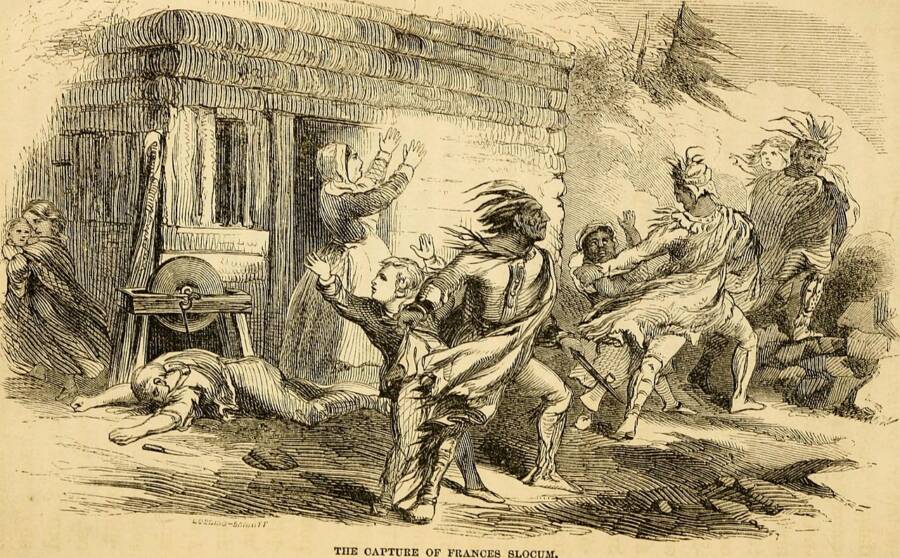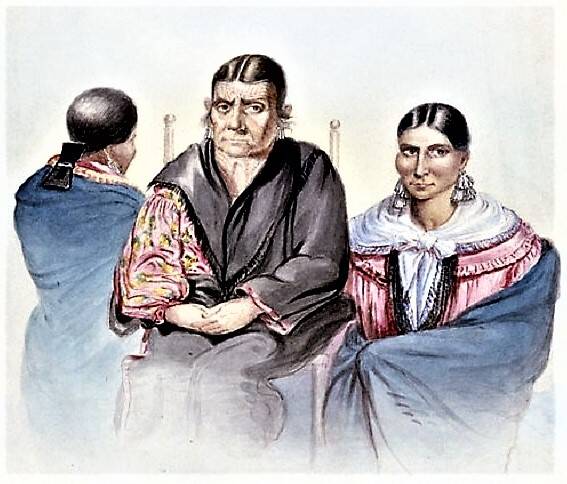In 1778, Frances Slocum was abducted by the Delaware tribe in Pennsylvania. She later married into the Miami tribe — and decided to never return home.
George Winter / Wikimedia CommonsA portrait of Frances Slocum from 1839 .
In 1778 , Delaware Native American warriors raided a whitened settlement in the Wyoming Valley of Pennsylvania . When they left , they carry off bundles of breadstuff and loot — and a five - yr - sometime missy name Frances Slocum .
For almost 60 years , the Slocum kinsperson wondered what had happen to their daughter . Both her parents died never knowing the truth . Then , in 1835 , Slocum confided in a lily-white trader that she ’d grown up in a Quaker family .

George Winter/Wikimedia CommonsA portrait of Frances Slocum from 1839.
But there had in reality been no need for Slocum ’s loved ones to worry about her prophylactic . From the solar day she was kidnapped , Slocum was treated like any other child in the tribe . She even went on to conjoin a chieftain of another kinship group .
All her life , Frances Slocum insisted on stay with the Native American kinsperson she have intercourse and loved . She then pass on to differentiate them the captivating tale of her life story as a white cleaning woman living in an Indigenous tribe .
Frances Slocum’s Early Life And Kidnapping
In the 1770s , Pennsylvania ’s Wyoming Valley was home to the Delaware Tribe of Indians . However , a growing number of European settlers were move into the orbit near modern - day Wilkes - Barre . The Slocums were one of those families .
hold to Jonathan and Ruth Slocum around March 4 , 1773 , Frances Slocum was one of 10 minor in a large Quaker family line . As the Revolutionary War raged , the Slocums move to Pennsylvania from their original home in Rhode Island in 1777 . But the war followed the crime syndicate .
According to theBiography of Frances Slocum , published in 1891 by John F. Meginness , in brief after the Slocums settled in the Wyoming Valley , a bloody conflict took place . Loyalists in the domain had ally with Iroquois raiders to attack pro - independence settlers .

Alonzo Chappel/Wikimedia CommonsThe Wyoming Massacre of 1778 targeted pro-Revolution settlers in Pennsylvania’s Wyoming Valley.
Alonzo Chappel / Wikimedia CommonsThe Wyoming Massacre of 1778 targeted pro - Revolution settlers in Pennsylvania ’s Wyoming Valley .
dire family fly to a nearby fortress and fought to the destruction . one C lost their lives in the Battle of Wyoming in July 1778 . The Slocums , who had befriended local Native Americans , survived . And instead of leave the area like many of the other survivor , the family decided to stay .
Frances Slocum ’s oldest sidekick joined a chemical group of Patriots who strike back against the tribes . The attack triggered a retaliation that would change the course of five - year - previous Slocum ’s lifetime .

George Peck/New York Public LibraryA 1858 depiction of the raid that captured Frances Slocum.
On Nov. 2 , 1778 , warrior from the Delaware Tribe raided the Slocum home in blanket daylight . allot to theHistory of Miami County , drop a line by John H. Stephens in 1896 , Slocum later on echo the details she could think back from that fateful twenty-four hour period .
“ Three Delaware Indians came suddenly to our household , ” she said . “ They defeat and scalp a homo by the door . A boy ran into the theater and he and I hide out under the staircase . The Indians came into the theater and upstairs … They carried us through the chaparral . ”
Frances Slocum locked eyes with her female parent as the raiders carry her out , but Ruth Slocum would never see her daughter again . The Slocum family expend the next 60 years wondering what happen to the darling little girlfriend .

Wikimedia CommonsThe house where Frances Slocum lived in Indiana.
Frances Slocum’s New Life With The Native Americans
During her first night as a prisoner , Frances Slocum recalled , “ I was very old-hat , and lay down on the flat coat and call out until I fell asleep . ”
George Peck / New York Public LibraryA 1858 depiction of the raid that becharm Frances Slocum .
According toIndiana Public Media , the Delaware warriors first take the five - class - old girl to a village not far from Niagara Falls .

George Winter/Wikimedia CommonsFrances Slocum and her daughters Kekenakushwa and Ozahshinquah.
“ The Indians were very genial to me , ” Slocum later related . “ When they had anything to eat , I always had the in force ; when I was tired , they carried me in their arms ; and in a unretentive time I start to feel much better and stopped crying . ”
Soon , Slocum adapt to her new life history . She fondly recalled a chief identify Tuck Horse : He “ dressed my hair in the Indian fashion and painted my face . He then dressed me up and put on me beautiful peag beads and made me look very fine . I was much pleased with the wampum . ”
An older Delaware couple who had lost all their children adopted Frances Slocum . They renamed her Weletawash , after their late daughter .
Slocum claim this practice was common among the Delaware federation of tribes . “ When the Indians thus fall behind all their tyke they often adopt some newfangled tyke as their own and treat it in all obedience as their own , ” she later said . “ This is the reason they often carry forth the children of livid people . ”
After spending some clip in Niagara Falls , Slocum moved to the lands wall New - sidereal day Detroit and then on to the Eel River near Fort Wayne , Indiana . She first we d a member of the Delaware Tribe named Little Turtle , and she later married a deaf chief of the Miami tribe named Shepoconah .
Among the Miami citizenry , Slocum took the name Maconaquah , which think of “ little bear . ” She and Shepoconah had four kid together and settle in a log cabin on the bank of the Mississinewa River near Peoria , Indiana around 1810 .
Wikimedia CommonsThe house where Frances Slocum lived in Indiana .
Their resolution on the river would finally became a key trading Charles William Post for Native Americans and white colonist . And it was this trading post that would lead Slocum back to her birth sept .
Slocum’s Family Finds Her Among The Miami People
George Ewing visited the Indiana trading post in 1835 . He spent the Nox on Slocum ’s farm , and as the Sunday solidification , the Miami woman he knew as Maconaquah told Ewing a fascinating story . She had been born to a Quaker family as Frances Slocum .
Ewing wanted to reunite Slocum with her birth house , so he published her story in a Pennsylvania paper , hoping to find keep congener interested in meeting their long - mislay sister .
When the story get to the Slocum family , nearly 60 years after their baby had been taken , three of Slocum ’s sibling directly direct for Indiana .
When Slocum ’s brother Isaac first saw her , he did not recognize her face . The woman before him had white haircloth and have on a half - twelve silver earrings . But a disfigured digit on the honest-to-god fair sex ’s hand revealed the truth — she was Frances Slocum .
George Winter / Wikimedia CommonsFrances Slocum and her daughters Kekenakushwa and Ozahshinquah .
The Slocums knew their sister would be unlike from her years live with the Delaware and Miami citizenry , but they were still blow out of the water that she could n’t think any English and relied on an interpreter to interact with them .
Slocum ’s sib invited her to return to Pennsylvania with them , but she had no desire to do so . harmonise to theNorth Manchester Historical Society , she differentiate her family , “ I have always lived with the Indians . They have always used me very kindly ; I am used to them . The Great Spirit has always allowed me to live with them , and I like to live and die with them . ”
“ I have a house and turgid land , two daughters , a Logos - in - law , three grandchildren , and everything to make me comfortable , ” she go on . “ Why should I go , and be like a fish out of water ? ”
Slocum ’s family returned to Pennsylvania without her , but they came back to visit over the eld . And while she always refused to return with them , she did finally agree to have her portrait paint . After a long life among Native Americans , Frances Slocum had formed a connection with her birth family once again .
The story of Frances Slocum quickly diffuse . Her tale of imprisonment — and her veneration to her adoptive folk — stunned white colonist . She became known as the “ White Rose of the Miamis . ”
In the 1840s , when the federal government sample to push the Miami multitude off their land , the Slocums helped their sis receive a Congressional grant for 620 Akka of nation around the trading post . Frances Slocum own it , and no one could take it from her .
When Frances Slocum died in 1847 at the long time of 74 , several monument were built in her honor . Today , the Frances Slocum State Park in Pennsylvania memorialise the spot where she was taken the day she was snatch from her home . And the Frances Slocum State Recreational Area and Lost Sister Trail in Indiana act as a testimonial to the young blanched young lady who was proudly raised among two aboriginal American tribes .
After record about the life of Frances Slocum , learn aboutHannah Duston , the white settler who killed her autochthonal captors . Then , discover the most importantNative American womenleft out of the history textbooks .